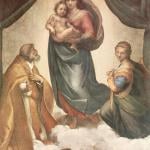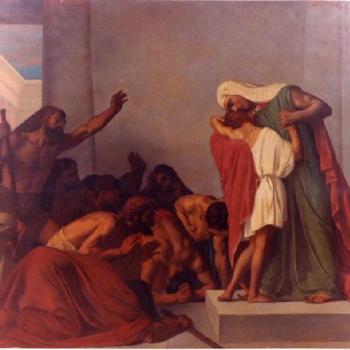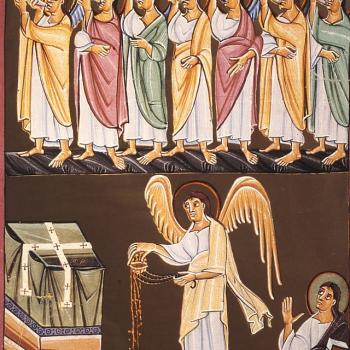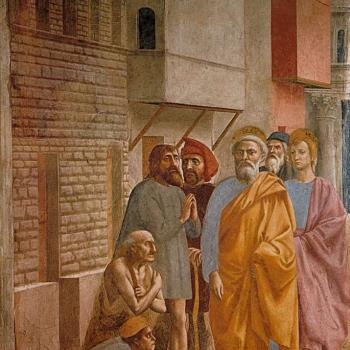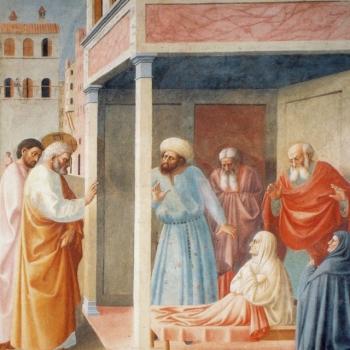
I cite The Latin Works of Huldreich Zwingli, Volume Three, edited and translated by Clarence Nevin Heller, Philadelphia: The Heidelberg Press, 1929. I am specifically addressing Zwingli‘s work, Commentary on True and False Religion (1525), which the Heller in his Preface describes as “The earliest truly comprehensive treatise on Protestant theology” and the first to present “the full-orbed Protestant faith.” He continues: “Zwingli presents an original and . . . comprehensive plan of arrangement and, therefore, justifies the claim that among Protestant system-builders he is the pioneer” (p. iii).
This is a reply to his section 29, “Statues and Images” (pp. 330-337). Zwingli’s words will be in blue.
*****
No one is so stupid as to think that we ought to do away with statues, images, and other representations, where no worship is offered them ; for who is affected by the flying cherubim on the mercy seat or embroidered on the curtains, whether for their mystic meaning or for decoration, or by the palms, lions, oxen, pomegranates, and such like ornaments cunningly wrought in Solomon’s temple [cf. I Kings 6: 1-38]? (pp. 330-331)
So far so good! But alas, John Calvin’s followers (with his approval?) thought it was required to smash organs in Catholic churches, because they were “idols.” Since we’re on the topic of “stupidity” is anyone so stupid as to think that any Christian not insane has ever worshiped a church organ as God? So why were they smashed?
Again, when they are worshipped, who is so senseless, not to say faithless, as to think they ought to be tolerated? (p. 331)
I am; since, as I will show, the Bible offers an indisputable instance of God being directly worshiped via an image (composed of matter) of His choosing.
But contentiousness again objects that not the images are worshipped, but those whose images they are. I answer that neither were any of the heathen ever so stupid as to worship their images of stone, bronze, and wood for what they were in themselves; they reverenced in these their Joves and Apollos. Hence, although the Holy Scriptures frequently mock at the worship of images, as if the worshippers worshipped wood and stone, yet everybody knew that they did not in the least worship these things, but in them those rather whom they regarded as gods. (p. 332)
This will be shown to be unbiblical when I provide the biblical example of what Zwingli claims is utterly impermissible.
First, because we have the worship of idols so expressly forbidden in both the New Testament and the Old. (p. 332)
Yes, of course. No one disagrees with this (including Catholics), because an idol is something (whether visual and material or not; money is an idol; so is sex or pride, etc.) that replaces God in our ultimate allegiances.
This is the distinction between the worshippers of the one true God and idolaters, that we worship a God who is invisible and who forbids us to make any visible representation of Him, while they clothe their gods with any shape they please. (p. 332)
It God wanted to be strictly invisible and to not be known or identified (or worshiped) in or by any image whatsoever, why are the following passages in the Bible?:
Exodus 3:2, 4-6, 16 (RSV) And the angel of the LORD appeared to him in a flame of fire out of the midst of a bush; and he looked, and lo, the bush was burning, yet it was not consumed. . . . [4] When the LORD saw that he turned aside to see, God called to him out of the bush, “Moses, Moses!” And he said, “Here am I.” [5] Then he said, “Do not come near; put off your shoes from your feet, for the place on which you are standing is holy ground.” [6] And he said, “I am the God of your father, the God of Abraham, the God of Isaac, and the God of Jacob.” And Moses hid his face, for he was afraid to look at God. . . . [16] [God speaking] “Go and gather the elders of Israel together, and say to them, ‘The LORD, the God of your fathers, the God of Abraham, of Isaac, and of Jacob, has appeared to me, . . .'”
Isaiah 6:1-5 In the year that King Uzzi’ah died I saw the Lord sitting upon a throne, high and lifted up; and his train filled the temple. [2] Above him stood the seraphim; each had six wings: with two he covered his face, and with two he covered his feet, and with two he flew. [3] And one called to another and said: “Holy, holy, holy is the LORD of hosts; the whole earth is full of his glory.” [4] And the foundations of the thresholds shook at the voice of him who called, and the house was filled with smoke. [5] And I said: “Woe is me! For I am lost; for I am a man of unclean lips, and I dwell in the midst of a people of unclean lips; for my eyes have seen the King, the LORD of hosts!”
Daniel 7:9 As I looked, thrones were placed and one that was ancient of days took his seat; his raiment was white as snow, and the hair of his head like pure wool; . . .
These are all images of God the Father. Note also the image of Jesus in Revelation 1:13-17 (“his head and his hair were white as white wool, white as snow; his eyes were like a flame of fire, his feet were like burnished bronze . . .” etc.). If God the Father willed to be strictly invisible, then He couldn’t and wouldn’t allow these images of Him to be seen and portrayed in Holy Scripture. But He did. Therefore, He’s not invisible. So the question is: why did Zwingli claim that He is?
Second, that it is not permissible to have images, even if they are not worshipped, is plain from the fact that the reason which leads them to assert that images can be made use of betrays our vast coldness; first, in that there is no love of God in us, for that is a sufficient spur to right living ; second, in that it is not safe to conform to any image but His who wishes not to be represented in visible form. . . . no images can kindle our hearts to the love of God. An image can rouse some trifling and fleeting emotion, but it cannot kindle love. (p. 333)
Again, if God the Father “wishes not to be represented in visible form” then why did He appear in visible form in the above three passages? There is not the slightest hint of disapproval in any of the passages. God wished it to be so, and to be recorded in His inspired, inerrant revelation.
It will be more evident that no images at all can be kept, . . . they cannot fail to have the appearance of evil. . . . they ought to be done away with when they are worshipped. (p. 334)
Funny, then, that God would do this at least three times, as shown. What’s He doing, idolizing Himself? How can He be so stupid?
Nobody attacks any images but those that are worshipped, . . . the greater and more precious it is in our sight the less is our trust in God. (p. 334)
Hold that thought and wait till you see the Scripture that I will shortly bring up!
If strange gods are forbidden by themselves and images by themselves, why do we not see that there is no further room for argument? . . . When, therefore, we admit that images are just as much forbidden as the gods whose images they are, why do we not in the same way admit that we cannot have images at all, . . .? (p. 335)
Because God not only presents Himself under various images but also expressly sanctions worship of Himself through an image. Stay tuned!
Next after these I do not think those images should be disturbed which are put into windows for the sake of decoration, provided they represent nothing base, for no one worships them there. (p. 337)
That’s good and sensible. Unfortunately, it’s well-known that many Calvinists smashed stained glass windows to smithereens, and stole hundreds of Catholic churches as well. Lutherans also engaged in wholesale stealing of churches, though they kept the stained glass. It’s still a mortal sin if they stole the windows and the buildings that they were in. Henry VII was the worst of all: stealing every Catholic Church in the whole of England.
In short, no one who has not experienced it has a right conception of how much the removal of the images aids true piety. (p. 337)
Too bad God didn’t get with that plan, as we shall see. And here is the clinching argument from Scripture:
Exodus 33:9-11 When Moses entered the tent [i.e., the Tabernacle], the pillar of cloud would descend and stand at the door of the tent, and the LORD would speak with Moses. [10] And when all the people saw the pillar of cloud standing at the door of the tent, all the people would rise up and worship, every man at his tent door. [11] Thus the LORD used to speak to Moses face to face, as a man speaks to his friend. . . .
Game, set, match . . . God is in the image of the pillar of cloud, speaking to Moses “face to face” and also being worshiped by the ancient Hebrews in the cloud. There’s no way out of it. Zwingli first objected to images, but then conceded that the heathen were worshiping the gods (as they conceived them) that the images represented; but then he objected to that, too (insofar as it would apply to the one true God), and made up a myth that all images whatsoever were forbidden by God and that He appeared under no image (since He is only invisible, so says Zwingli).
This passage annihilates his already weak argument. Yes, we condemn idolatry and graven images (pieces of stone or wood that people worshiped or worshiped as representatives of false gods). But this is not that. It’s God’s expressed will, in His revelation. This recorded the practice of the Hebrews during the exodus. They saw the pillar of cloud (that God says several times in the Old Testament that He was “in”: along with the pillar of fire) and they worshiped God through or in the image. The image can’t possibly be separated from it.
The text doesn’t condemn the practice, as it must do if Zwingli is correct. So folks must make a choice. Here, Zwingli pits himself against clear biblical revelation. At that point, everyone has to make a choice: Zwingli or God and the Bible which is His inspired word. I will do what Joshua did:
Joshua 24:15 . . . as for me and my house, we will serve the LORD
We should worship God in the pillar of cloud, if that’s how He chooses to appear to us. We could also have worshiped Him in the burning bush and on His throne (Isaiah 6) and as a Person with white hair sitting on His throne (Daniel 7); all images; all permissible and never condemned. We can also note the many theophanies in the Old Testament as well. Abraham saw God in the form of a man and worshiped Him:
Genesis 18:1-2 And the LORD appeared to him by the oaks of Mamre, as he sat at the door of his tent in the heat of the day. [2] He lifted up his eyes and looked, and behold, three men stood in front of him. When he saw them, he ran from the tent door to meet them, and bowed himself to the earth,
Abraham worships God, Who had appeared as one of three men. The text goes on to record conversations, with reference to “the LORD said” (to Abraham) five times (18:10, 13, 17, 20, 26). And it says, “Abraham still stood before the LORD” (18:22). Finally, it concludes, “And the LORD went his way” (18:33). No one can argue, therefore, that these are all mere angels. We see lots of refutations of Zwingli’s iconoclastic, anti-image, anti-biblical nonsense there, too . . .


